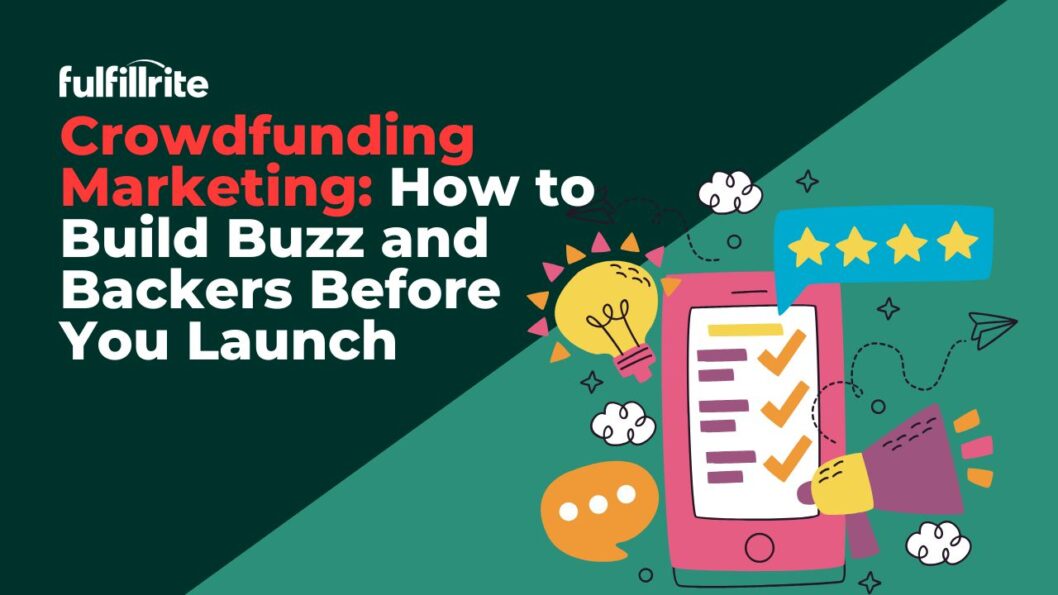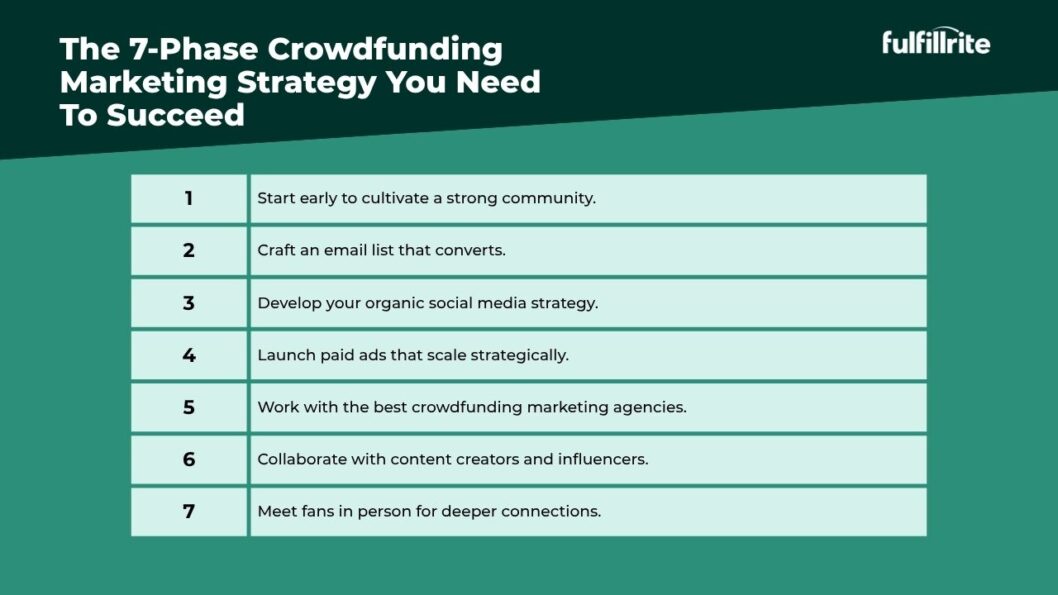You’ve spent months designing your product. You’ve run the numbers, found your manufacturer, and picked your crowdfunding platform. Everything is ready to go.
But even the very best product in the world won’t fund itself. You need a rock solid marketing plan or your campaign will sputter out before it gains traction.
The difference between campaigns that barely scrape by and those that blow past their goals often comes down to one factor: how well they built their audience before hitting the launch button.
And it’s because of this simple fact that crowdfunding marketing isn’t just about promoting a campaign. It’s about building relationships, creating anticipation, and turning strangers into believers who’ll back your project on day one. This guide will walk you through exactly how to do that.
Key Takeaways
- Start building your audience 3-6 months before launch
- Email lists tend to convert better than any other marketing channel
- Test your messaging and ads on small budgets before scaling
- Face-to-face connections at events make lasting impressions
- The best campaigns combine organic community building with strategic paid advertising
What Is Crowdfunding Marketing and Why It Matters
Crowdfunding marketing is all about building awareness and a community first, and then converting them into backers for your campaign. Like with any kind of product launch, crowdfunding marketing isn’t just one single tactic. It’s a coordinated and sustained effort that starts way, way before you click “launch.”
The goal is threefold: build a community of people who care about your product, create brand awareness so your campaign doesn’t launch into a void, and convert that awareness into actual pledges.
Here’s why this matters so much: most people won’t back a project the first time they see it. They need to hear about it multiple times, from multiple sources, before they’re comfortable pulling out their wallet. That’s especially true on platforms like Kickstarter and Indiegogo, where backers are taking a chance on a product that doesn’t exist yet.
No amount of innovation can overcome poor marketing. We’ve seen incredible products fail to fund because nobody knew they existed. And we’ve seen decent products wildly exceed their goals because the creators did the groundwork to build an audience first.
The 7-Phase Crowdfunding Marketing Strategy You Need to Succeed
The campaigns that rapidly reach their goals don’t wing it. They follow a clear roadmap that covers every stage of the journey. Here’s what that roadmap looks like.
1. Start Early to Cultivate a Strong Community
The single biggest mistake first-time creators make couldn’t be simpler: waiting until launch day to start marketing.
If you want strong momentum from day one, you need to start building your community at least three to six months before launch. That gives you time to gather interested people, warm them up, and turn them into day-one backers.
Start documenting your journey on social media. Share photos of prototypes, talk about the problems you’re solving, and give people a behind-the-scenes look at what you’re building.
Join online communities where your target customers hang out such as Reddit, Facebook groups, Discord servers, and participate authentically. Answer questions and become a helpful presence. Don’t just drop links.
Set up a simple landing page with an email signup form. Keep the copy clear: “Be the first to know when we launch.” That’s your foundation. Everything else builds from there.
2. Craft an Email List That Converts
Email is still the most powerful tool in your marketing arsenal. Social media platforms change their algorithms. Ad costs fluctuate. But your email list is 100% yours, and nobody can take it away.
The goal is to collect qualified leads—people who are genuinely interested in what you’re building. Use tools like ConvertKit or Klaviyo to manage your list and automate follow-up sequences.
Give people a reason to sign up. Offer exclusive updates, early-bird pricing, or a sneak peek at features nobody else has seen yet. As your launch date gets closer, send countdown emails that build anticipation.
Email marketing consistently delivers better ROI than other channels because you’re talking directly to people who already raised their hand and said they’re interested. Don’t sleep on it.
3. Develop Your Organic Social Media Strategy
Organic social media is about consistency and authenticity. You’re not trying to go viral. You’re trying to build relationships with people who might back your campaign.
Post regular updates showing your progress. Share behind-the-scenes content that gives people a sense of who you are and why you’re building this thing. Ask for feedback on design choices or feature ideas. People love feeling like they’re part of the process.
Work your way into trending topics to reach beyond your existing followers. Respond to every comment and DM. Show up in conversations happening in your niche, and be helpful without being salesy.
Different platforms work better for different types of campaigns. Instagram and TikTok are great for visually appealing consumer products. LinkedIn works well for B2B or professional tools. Reddit can be powerful if you approach it the right way—but don’t spam. The key is showing up where your audience already is and adding value to the conversation.
4. Launch Paid Ads That Scale Strategically
Organic reach only gets you so far. Paid advertising lets you amplify your message and reach people who’ve never heard of you.
The mistake most creators make is dumping money into ads without testing first. Start lean. Run small tests on Facebook, Instagram, or Google to see what messaging resonates. Track your cost per lead and your conversion rates. Once you find ad creative that works, then you scale.
A great example is Botany, a flower-themed board game campaign. They started by spending just $5,000 on pre-launch ads to test different audiences and messaging. That initial spend brought in 4,407 email signups. When they saw the numbers working, they increased their budget to $13,000 and grew their list to 8,700 people. On launch day, they generated $105,965—mostly from that email list they built through ads.
The key lesson here is to always test, measure, and scale. Spend money only when it’s making money. Watch your return on ad spend (ROAS), and adjust your budget based on performance.
5. Work With the Best Crowdfunding Marketing Agencies
At some point, you might realize you need expert help. Running a crowdfunding campaign while also managing marketing, fulfillment planning, and customer service can definitely feel like a lot. Especially if it’s your first time.
That’s where specialized agencies come in. The best crowdfunding marketing agencies know the platforms inside and out. They’ve run hundreds of campaigns and know what works.
LaunchBoom is known for pre-launch testing and scaling strategies. They’ve raised over $200 million for physical product campaigns. Jellop specializes in powerful paid ad scaling for active Kickstarter and Indiegogo campaigns. Rainfactory focuses on hardware and tech with full-funnel marketing execution. Enventys Partners provides creative production alongside digital ad strategy and PR services. Funded Today offers broad support across various crowdfunding niches.
When choosing an agency, look at their case studies. Consider questions such as:
- Do they have experience with campaigns like yours?
- What results have they delivered
- What’s their pricing structure, and does it align with your budget?
Not every campaign needs an agency. But if you’re raising six figures or more, or if marketing isn’t your strong suit, bringing in experts can be worth the investment.
6. Collaborate with Content Creators and Influencers
Getting featured by the right content creator can introduce your product to thousands of potential backers in one shot.
Podcast interviews, YouTube product reviews, and influencer shoutouts reach hyper-targeted audiences who already trust the creator’s recommendations. The key is building real relationships, not just buying shoutouts.
Start by identifying creators whose audience overlaps with your target market. Reach out with a personalized pitch. Offer to send them a prototype or early access in exchange for honest feedback.
The best partnerships are long-term. A creator who genuinely loves your product might mention it multiple times, which builds more credibility than a one-off sponsored post ever could.
7. Meet Fans in Person for Deeper Connections
Online marketing is powerful, but don’t underestimate face-to-face connections.
Conventions, expos, and maker fairs let you meet potential backers in person. You can demonstrate your product, answer questions on the spot, and create memorable experiences that turn casual interest into genuine enthusiasm.
Face-to-face engagement builds the kind of advocacy that lasts beyond your campaign. People who meet you in person are more likely to back your project and tell their friends about it.
The right events depend on your industry. Board game creators should hit up conventions like Gen Con or PAX. Consumer tech products fit well at CES or Maker Faire. Local events and pop-up shops work for campaigns with strong regional appeal.
Example Campaigns That Nailed Their Marketing for Crowdfunding Campaigns
Let’s look at two campaigns that executed their crowdfunding marketing strategy brilliantly. Each offers specific lessons you can apply to your own launch.
Botany: Data-Driven Ad Testing and Email List Building
Botany, the flower-themed board game campaign mentioned a little while ago, is a masterclass in disciplined ad spending and email list building.
They didn’t just throw money at Facebook and hope for the best. They started small, testing different audiences and ad creative with an initial budget of $5,000. That generated 4,407 email signups. Once they confirmed their ads were working, they increased their spend to $13,000, growing their list to 8,700 qualified leads.
On launch day, they generated $105,965. Most of that came from the carefully cultivated email list. But they didn’t stop there and instead continued scaling their ads intelligently. On one day in particular, they spent just $400 in ads and generated $4,200 in pledges from those ads, earning a 10.5x return on ad spending.
By the end of their campaign, they’d spent $125,000 on ads and raised over $1 million. This was not the result of luck, but rather of systematic testing, measuring, and scaling.
The key lesson from Botany: test, measure, and scale. Spend money only when it makes money. Track your benchmarks obsessively, and increase your budget only when the numbers justify it.
Piper: Strategic Launch Timing and Community Reservations
Piper, a pepper grinder, took a different but equally effective approach.
Instead of relying solely on organic reach, they ran a systematic pre-launch campaign. They tested ads targeting different customer segments and drove traffic to a landing page designed to collect emails and campaign reservations.
Before going live, they hit two critical benchmarks: 10,000 email signups and 1,900 reservations. Those reservations were people who’d committed to backing the campaign on day one.
They also delayed their launch to avoid competing with Prime Day and July 4th. They knew those major selling events would divide attention and reduce their impact. By waiting for clearer timing, they ensured stronger launch-day performance and higher conversion rates.
Piper’s lesson: timing matters. Don’t launch into a crowded moment. And use reservations to build commitment before your campaign goes live.
Best Crowdfunding Marketing Agencies You Should Know
If you’re considering hiring outside help, here’s a quick guide to some of the top players in the crowdfunding space.
LaunchBoom is known for pre-launch testing and scaling strategies. They’ve raised over $200 million for physical product campaigns and focus heavily on building email lists through paid ads before launch.
Jellop specializes in powerful paid ad scaling for active Kickstarter and Indiegogo campaigns. If you need to further grow an already-live campaign, they’re a strong choice.
Rainfactory focuses on hardware and tech products, providing full-funnel marketing execution from strategy through creative production and media buying.
Enventys Partners is known for their creative production and strength with digital ad strategy and PR services. They’re a good fit if you need help across multiple channels.
Funded Today is good for those who need broad support across various crowdfunding niches, and they have a track record across thousands of campaigns.
When choosing an agency, consider your campaign type, budget, and where you need the most help. Ask for case studies in your niche and proof of past performance. The right agency can be a force multiplier, but this is only the case if there’s strong alignment between their approach and your goals.
Final Thoughts
Crowdfunding marketing isn’t magic. But it doesn’t need to be!
Instead, it’s a combination of smart strategy, consistent effort, and data-driven decision-making.
The single best thing you can do is start early. It’s never too soon to build your email list or test your messaging before you scale. An early beginning makes it easier to combine organic community building with strategic paid advertising. And don’t be afraid to bring in expert help if you need it.
The campaigns that succeed aren’t always the ones with the best products. They’re the ones that did the work to build an audience, create buzz, and turn that buzz into backers.
If you’re planning a crowdfunding campaign, start making your marketing roadmap today. And if you need help, consider bringing on an expert team. You’d be amazed at just how much you can do with the backing of a proven crowdfunding marketing partner like LaunchBoom to guide you through the process.
Crowdfunding Marketing: Frequently Asked Questions
What Is a Crowdfunding Marketing Strategy?
A crowdfunding marketing strategy is a plan. As part of that plan, you need to account for how you’ll find your audience, build awareness, and convert that awareness into backers. This process typically starts 3-6 months before launch and includes pre-launch audience building, launch-day promotion, mid-campaign optimization, and post-launch fulfillment communication. The best strategies often combine many types of marketing, including email marketing, social media, paid advertising, influencer partnerships, and in-person events into a coordinated effort.
How Do You Market a Crowdfunding Campaign?
You market a crowdfunding campaign much like you would any other kind of a product launch. And in all likelihood, that will include using both organic and paid marketing tactics. Start by building an email list months before launch using a landing page and lead magnets (that is, incentives to sign up for your list).
You can also post regularly on social media showing your product development. You’ll often hear people call this “building in public.”
To further push things along, you can run paid ads on Facebook, Instagram, or Google to amplify your reach. You can also partner with influencers and content creators who can introduce your product to their audiences. And consider attending in-person events where you can demonstrate your product and build deeper connections. Each tactic serves a core goal: building community, driving conversions, or increasing content visibility.
Who Are the Best Crowdfunding Marketing Agencies?
The best crowdfunding marketing agencies include:
- LaunchBoom: known for pre-launch testing and scaling
- Jellop: known for paid ad scaling for active campaigns
- Rainfactory: focused on hardware and tech with full-funnel execution
- Enventys Partners: combining creative production with ad strategy and PR
- Funded Today: offering broad support across multiple niches
As you consider different agencies, it’s a good idea to ask for case studies. You want to proof of past campaign performance, ideally with a similar product. There’s no single right agency to go with, so remember that you want to choose your partner based on your type of campaign, overall budget, and the areas you feel you need the most support.
What Are Some Tips for Crowdfunding Marketing Success?
Start building your email list at least three months before launch. Test your messaging and ad creative on small budgets before scaling. Repurpose your best organic content for paid ads to extend its reach.
Be sure to provide consistent communication with your audience throughout the campaign. The worst thing you can do, once the funds clear, is disappear after you receive them.
Track your metrics obsessively: cost per lead, conversion rates, and return on ad spend. And remember that community building beats hard selling every time. People back projects they feel connected to, so focus on building genuine relationships.
How Much Should I Budget for Crowdfunding Marketing?
Marketing budgets vary widely based on campaign size and goals. Smaller campaigns might spend $5,000-$15,000 on pre-launch ads and creative. Mid-sized campaigns will often spend closer to $25,000-$75,000 for ads, agency support, and production. Large campaigns can spend $100,000 or more on large-scale marketing efforts.
Ad spend is just one cost to consider, though. You need to also think about all the costs associated with creative production (photos, videos), agency retainers (if you’re hiring help), marketing tools (email software, landing page builders), and platform fees. In general, it’s a good idea to budget about 10-30% of your funding goal for marketing.
When Should I Start Marketing for My Crowdfunding Campaign?
Marketing should generally start 3–6 months before you launch. That way, you have enough time to build your email list, create landing pages, test your messaging, and build up some organic buzz.
When you’re about 3–4 months out, it’s wise to start posting organic content and testing small ad campaigns. Around the 1–2 month mark, you can then ramp up ad spend and start contacting influencers.
In the final 2 weeks of pre-launch, you’ll want to send countdown emails and coordinate on PR.


